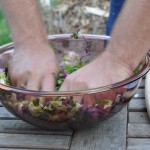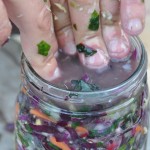Organic gardeners are health conscious folks, and there's no more healthy a way to preserve your bumper crops then through the use of fermentation! Giving Tree Gardens would like to empower folks everywhere to take their health into their own hands, through the magic of vegetable fermentation - an ancient human cultural tradition.
Fermenting With Wild Abandon!
Cabbage is our friend. The cabbage plant is a cultivar of the wild mustard green. Cabbage and all of it’s Brassicaceae family relatives including kale, cauliflower, kohlrabi, collard greens, brussel sprouts, turnip, radish, rutabaga, bok choy, broccoli, and more all have growing on their surface a bacteria called lactobacillus plantarum. This beneficial organism is exactly the right microbe to help the human body digest and get the most nutrition from our foods. Lactobacillus is responsible as well for the tangy unique taste that sauerkraut and kimchi offer. So our friend the cabbage, and all of it’s relatives, freely offer us all of their delicious healthy nutrition, that's what I call POWER KRAUT!
Of course any northern gardener whose grown kales, or cabbages knows these beauties keep growing strong well past frost. The fact that these amazing plants are able to feed us through the cold weather in both fresh and fermented forms make the brassicaceae family of plants a natural companion of humankind.
Kimchi For a Better Tomorrow
Listed by Health Magazine as one of the top 5 most healthy foods in the world, kimchi is an easy to make human-health-aid. A traditional Korean ferment, kimchi is an extremely adaptable recipe. The recipe that I present below is one of my favorite flavors of kimchi but it is very important to note that kimchi is best made from whatever your personal favorite vegetables and spices happen to be.
Ingredients:
5 pounds of your favorite vegetables
(I often use green and red cabbage, carrots, and kohlrabi)
1-2 big onions
4-5 chili (or your favorite flavor of) peppers
3-4 cloves of garlic
6 tablespoons of fresh grated ginger
3 tablespoons of sea salt
Process:
Chop your vegetables to whatever texture you prefer. I like to chop them to into fairly thin slices. Place the chopped veggies in a mixing bowl and mash them together with salt. By mash I mean that you need to break up the cell walls of the vegetables so as to begin to squeeze out the vegetables natural juices therefore forming a brine. I use my hands to squeeze the veggies, or sometimes I use an empty jar to smash and squish them. Once you can begin to see juices squeezing out of your veggies, set them aside for a moment.
Now it’s time to spice things up.
Make sure you’re using fresh spices and not any pre-chopped or prepared spice mixes as these often contain anti bacterial agents that could harm
the beneficial microbes that form our ferment. Next you’ll want to shred your spices together. I use a food processor as these powerful spices make me cry when I shred them by hand. Blend up the onions, peppers, garlic, and ginger together.
If you're starting to fear that this is going to be way too spicy of a dish, consider that the hot spicy flavors we’re adding here will mellow and become much more tame as fermentation occurs. I’ll often add horseradish root, and more types of peppers to the spice list, really it’s hard to over-spice kimchi.
Once you’ve ground up your tear inducing spices, you’ll mix them together with the juicy vegetables, and then it’s time to pack them in a jar or vessel.
Potential vessels for your kimchi include: glass jars, ceramic containers, and in a pinch you can use plastic containers. Never store your ferments in metal containers as the metal will cause chemical changes to your brine that will ruin your kraut. The best container will fit the amount of kimchi that you produce without much room left over. I’ll often use a variety of small jars to accommodate a large kimchi production.
Once your vessels are chosen, you need to begin to tightly pack the kimchi into your jars so that the veggies become submerged under the salty brine. Push the kimchi down firmly into your vessel with your fingers or an empty jar until the jar is almost full, and a layer of brine covers the vegetables.
Covering your jar can be accomplished in a number of ways. You can use a cloth covering held with a rubber band, or I prefer to use a plastic or metal lid that fits the container.
Now that your kimchi is packed tightly into a covered lid, find a home for it in your kitchen. I put mine on top of the fridge because this provides a nice evenly warm temperature. You may want to choose a more in the way sort of spot for your first kimchi’s as fermenting kimchi requires some attention and maintenance.
No matter where you place your filled kimchi vessel, you’ll want to check on it daily for the first couple weeks. Once a day take the lid off of your vessel. If you choose a tight fitting lid, you’ll notice air pressure release out of the jar when you twist it open. This is from gas that is naturally released during fermentation. As the gas forms in your ferment, air spaces will develop throughout the jar. Each time you check on your kimchi, you’ll want to squish the veggies back down until they are once again covered in brine.
After only 3 days of fermenting, your kimchi will begin to develop a tangy flavor. This unique taste will let you know that your kimchi is ready to start eating. Taste your new ferment on a daily basis each time you check in on it. I’ll sometimes allow ferments to sit on top of the fridge for a few months, all the while I’m tasting the different stages of growth that occur as the microbes develop in my jars and making sure to squish the kraut as needed to keep it submerged under brine. As soon as the flavor strikes my fancy, I’ll put the kimchi jar into the fridge to slow down the fermentation process and preserve the flavor that I’m enjoying.
Flavor, sustenance, and health are a few of the benefits everyone can reap from fermenting their own foods. When folks decide to grow their own healthy foods, and share their recipes freely, the entire human culture benefits. With all the hoopla in this country surrounding health care reform, it’s high time we all became empowered to make ourselves healthier, stronger, and more independent. Kimchi, kraut, and all your favorite garden ferments are an easy, effective way of growing our own health, on our own terms.









